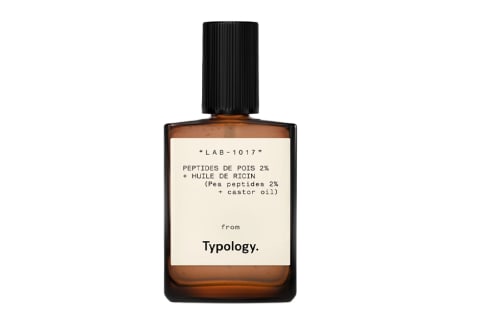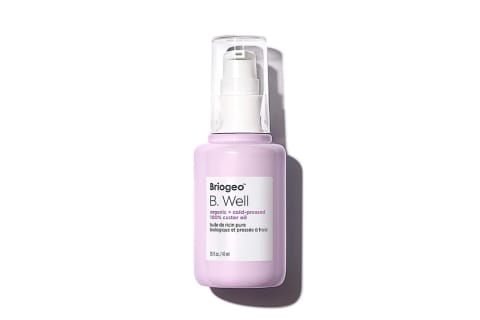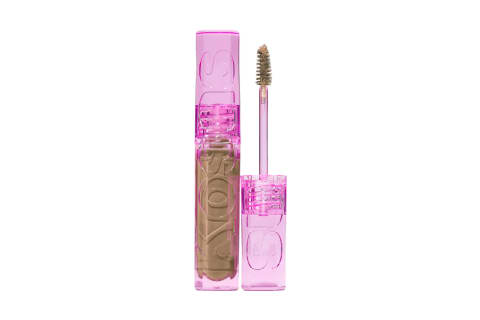Advertisement
Castor Oil For Eyebrows: Does It Help Them Grow? Experts Weigh In + How To Use It


Take a peek at a few brow-growth serums, and you might notice a familiar ingredient etched on each label: castor oil. That's because this rich oil has been used for ages by beauty fans of many backgrounds, beloved for its moisturizing and antioxidant capabilities—some even swear the straight oil helps them grow full, luscious arches.
You might have heard accounts about the famed oil for hair growth in general, maybe a whisper or two about eyelashes, but what about castor oil for eyebrows? Well, wonder no more: Experts weigh in, below.
What is castor oil?
Castor oil is a vegetable oil extracted from castor beans. It has a notably high fatty-acid content (around 85 to 95% ricinoleic acid1, in fact), plus antioxidants and minerals aplenty.
"Castor oil has documented1 anti-inflammatory2, anti-allergenic, antioxidant, antifungal, antimicrobial3, immune-boosting, and analgesic properties," integrative medicine physician Bindiya Gandhi, M.D., tells mbg about the health benefits of castor oil. The oil has long been used as a beauty staple for decades in both Ayurvedic traditions and Black households (read more about the anti-inflammatory, moisturizing oil here).
In beauty products its most often used as an emollient in skin care (such as in lip balms) or in hair growth products, such as hair, lash or brow growth treatments.
Can castor oil help your brows grow?
Short answer? Maybe. "There's no published data showing that castor oil can help, but I do have the occasional patient who swears by it," notes board-certified dermatologist Whitney Bowe, M.D., about castor oil for hair growth. However not having published data to prove it works doesn’t mean that it doesn’t work, it just means that it simply hasn’t been studied at this time—and to be honest, few ingredients have robust data to support brow growth claims. So it’s not just castor oil that’s currently lacking in studies—it’s just not a well studied area of beauty at the moment.
Even without clinical data, though, it makes sense why some do see success: Castor oil's antioxidant and fatty acid content feeds the delicate brow hairs with nutrients, which can help combat free radical damage and inflammation (and for what it’s worth: both are linked to hair aging4 and hair loss).
Castor oil is also incredibly moisturizing—it's both an emollient and an occlusive, which means it penetrates the strands with ease as well as seals in moisture. (This is also great news for your eyebrows, as moisturized brows do tend to grow fuller.) Keeping the strands happily doused in moisture is crucial for staving off hair loss as well, so even if the famed oil doesn't cause growth, per se, it can keep the wisps you do have healthy.
However, you’ll see anecdotal evidence abound with castor oil. Lots of folks swear the ingredient spurs healthy hair growth on the scalp, lashes, or brows. Perhaps because "it depends on the length of the anagen (or growth) phase of your hair to begin with," board-certified dermatologist Jeanine Downie, M.D., previously told mbg. Meaning, those with a naturally longer brow-growth phase may see profound benefits from using castor oil. (And others may not see noticeable differences—that’s the challenging thing about anecdotal evidence, it’s entirely subjective.)
So, what's the verdict? We still can't say whether coating your brow hairs with castor oil will, without a doubt, help them grow fluffy and full. There's no clinical research to back up the claims—no matter how striking some people's results may be—but the specific compounds and properties of castor oil do carry some scientific weight. And as board-certified dermatologist Ava Shamban, M.D., founder of SKINFIVE, tells mbg, "There is no denying its anecdotal powers and prowess."
The summary:
How to use castor oil on the brows:
Even if castor oil doesn't stimulate actual regrowth, it does coat your brow hairs with moisture—that alone is reason to dabble with the beauty staple.
Remember: Dry, brittle strands (both on your head and brows) can lead to breakage5, which can ultimately hinder hair growth.
But! You don't just want to slap on the castor oil and call it a night—here's exactly how to apply the product for maximum benefits:
- After cleansing your face, make sure to remove any lingering makeup on the brows (brow gel, brow powder, and the like can block the oil). Although, you might not want to use an oil-based remover: As Shamban previously told mbg about using castor oil on lashes, oil-based removers can leave a film on the hair and preclude the castor oil from penetrating the wisps. (Here are other natural makeup remover options, some of which are oil-free.)
- Brow and lash expert Jasmine Imani suggests giving the brows a very gentle exfoliation next. No, this doesn’t mean reach for a harsh scrub or acid. Simply grab a clean spoolie and brush it through your brows—almost lille you’re combing your hair. This will help remove dead skin cells and buildup from the hair follicles, as well as encourage circulation to the area.
- Next, dip a clean cotton swab, thin brush or spoolie into the castor oil and paint it gently along your brows, an even coat from base to tail.
- When you go to bed, you might want to try sleeping on your back so you don't smear any of the oil into your pillow. (Plus, sleeping on your back has a host of other skin care benefits.)
- In the morning, gently wash off the remaining oil with water or makeup remover. You can carry on with the rest of your morning skin care routine, or if there's still some lingering oil in those hairs, take a cotton swab soaked in makeup remover (this one can be oil-based) and run it back and forth across the brows. When you go in the opposite direction of hair growth, you should be able to pick up stubborn product.
Side effects of castor oil
Castor oil is a well tolerated ingredient to use on the skin. Of course, everybody is different and you should always consider your own unique sensitivities before applying any oil, ingredient or extract. We recommend patch testing formulas on the wrist prior to applying them on your face (where a reaction is much more noticeable).
And of course, any product has the potential to backfire when used incorrectly. Specifically with castor oil, it should be used as a brow conditioner and rinsed off. Layering on oil after oil without proper removal has the potential to cause buildup. Buildup can suffocate the hair follicle, causing damage and even hair loss. While it would take repeated use over a long period of time to get to this point, it’s of course worth noting.
Finally, while this isn’t a side effect, it’s important to set expectations for any hair growth ingredient (not just castor oil!). Hair growth (be it on your head, lashes, or brows) is complicated and multifaceted. Hair loss in brows in particular is often caused by age, overplucking or styling, diet, and even stress—so the answer to regrowth may not be as simple as swiping on a brow gel. And in some cases, brow regrowth isn’t possible (such as in the case of scar tissue). Some folks find success with topical treatments, while others don’t. If your brow regrowth journey is causing you stress, visit a dermatologist or brow specialist for more information on your options.
Alternatives to castor oil
Castor oil isn’t the only ingredient beloved for the brow area, here are some other ingredients to look for—be it as a stand-alone ingredient or in a brow growth serum.
- Coconut oil. Imani notes that in addition to castor oil, she loves coconut oil as a brow conditioner. Since coconut oil has a low molecular weight6, it's able to penetrate easily into the hair shaft and absorb better than other common oils. In addition it helps hairs hold onto proteins7 more effectively.
- Peptides. Peptides are chains of amino acids linked together by peptide bonds, and amino acids are the building blocks of proteins, such as keratin, the protein that makes up your hair. There’s some data that shows these may encourage hair growth8.
- Rosemary oil. Rosemary oil has been clinically studied for hair growth with promising results9. See, rosemary is a fabulous herb for stimulating circulation on the scalp. Add 1 drop into your carrier oil (be it coconut oil, castor oil, or something else) prior to coating the strands.
- Jojoba oil. While jojoba isn’t known or studied for hair growth, it is a fabulous multi-use oil that’s great for skin, hair, scalp, and brows. It has a similar composition to your natural sebum, so it doesn’t feel too gunky on the face.
FAQ
Which oil is the best for eyebrow growth?
Castor oil is a beloved oil for the hair and skin, and has anecdotal evidence suggesting it may be good for hair growth, including around the brows.
Coconut oil makes for an excellent brow conditioner. Since coconut oil has a low molecular weight, it's able to penetrate easily into the hair shaft and absorb better than other common oils. In addition it helps hairs hold onto proteins more effectively.
Jojoba oil is a multitasking oil that’s similar to our natural sebum, so it absorbs easier on the face.
How long should I leave castor oil on my eyebrows?
Use castor oil like a brow conditioner, notes brow and lash specialist Jasmine Imani. After washing your face, gentle brush the brows with a clean spoolie. Then add a few drops of the castor oil to the tips of your finger and gently massage in the oil to the brow area. You can leave the oil on for a few minutes, hours, or even overnight. Just be sure to rinse it off as not to contribute to buildup in the hair follicle.
How long does it take for castor oil to work on the eyebrows?
You can expect to see potential brow regrowth within 2 to 3 months after you've stopped plucking. This growth may be aided by castor oil, however at this time there’s no clinical data to confirm. And an important reminder from board-certified surgeon William Yates, M.D.—an American Board of Hair Restoration Surgery hair expert and the founder of the haircare brand Dr. Yates MD Hair + Science—who says that "eyebrows that have endured chronic overplucking...may not respond to normal regrowth." Read more about brow regrowth timing here.
The takeaway
Will castor oil help you sprout bold, fluffy brows? There isn't a singular answer—some people swear by it, while others don't see any notable growth (especially if your brows are scarred or overplucked, as no ingredient can magically revive dead, damaged follicles). However, castor oil is incredibly moisturizing, and wrapping the brow hairs with its rich fatty acids never hurts—healthy, hydrated brows do look fuller, even if the actual growth rate doesn't quicken. Once you get the brow growth your after, then you can look into how pros recommend shaping the brows.
9 Sources
- https://www.ncbi.nlm.nih.gov/pmc/articles/PMC5015816/
- https://pubmed.ncbi.nlm.nih.gov/33037703/
- https://pubmed.ncbi.nlm.nih.gov/11771574/
- https://www.ncbi.nlm.nih.gov/pmc/articles/PMC2929555/
- https://www.ncbi.nlm.nih.gov/pmc/articles/PMC4387693/
- https://pubmed.ncbi.nlm.nih.gov/22487449/
- https://pubmed.ncbi.nlm.nih.gov/11413497/
- https://pubmed.ncbi.nlm.nih.gov/8326148/
- https://www.ncbi.nlm.nih.gov/pubmed/25842469


